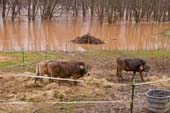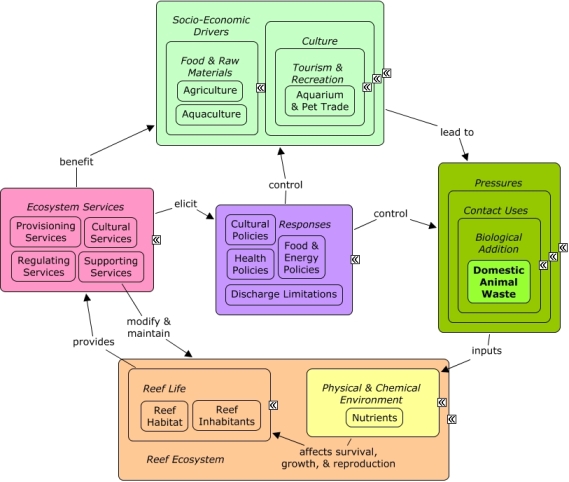ReefLink Database

Domestic Animal Waste
Domestic Animals Waste includes solid waste produced by animals, including pets, agricultural animals, as well as stray and feral animals.
CMap

CMap Description
The activities of socio-economic drivers can create biological additions into the reef ecosystem. Domestic animals, including agricultural animals or stray animals in cities, can lead to runoff of waste into coastal waters. Many of the same socio-economic sectors that produce domestic animal waste benefit indirectly from goods and services provided by the reef that provides recreational opportunities and contributes to the cultural identity of the local community and drives coastal development. Health policies, education, or agricultural policies can be enacted to clean up cities and reduce domestic animal waste.Citations
| Citation | Year | Study Location | Study Type | Database Topics |
|---|---|---|---|---|
| 2011. Nonpoint Source Management Program 2010 Annual Report. Document # DEPLW-1205, Maine Department of Environmental Protection, Augusta, (Maine, USA). | 2011 | Field Study & Monitoring | Agriculture; Banks, Credit, & Securities; Chemical Use Regulations; Domestic Animal Waste; Fertilizer & Pesticide Use; Forestry; Housing; Impervious Surfaces; Microorganisms; Non-point Source Runoff; Nutrients; Physical & Chemical Water Quality Criteria; Point Source Discharges; Surface & Groundwater Flow; Wetlands | |
| Jokela, Bill, Peter Kleinman, John Peters, and Ann Wolf,. 2011. Manure Spreader Calibration & Manure Testing. | 2011 | Field Study & Monitoring | Domestic Animal Waste; Nutrients | |
| Muniz, M. A., J. G. Barbosa, J. A. S. Grossi, M. Y. Orbes, and P. G. Sa. 2009. Production And Quality Of Pot Chrysanthemum Fertirrigated With Different Nitrate/Ammonium Relations. Bioscience Journal 25:75-82. | 2009 | India | Domestic Animal Waste; Irrigation | |
| Koener, R. M. and J. R. Koerner. 2008. Review and analysis of GRI-21 conference. Page 50 in Geosynthetics. | 2008 | South & Central America; Mexico | Review | Agriculture; Aquaculture; Artificial Habitat; Domestic Animal Waste; Fish; Tourism & Recreation |
| Schroder, P., R. Herzig, B. Bojinov, A. Ruttens, E. Nehnevajova, S. Stamatiadis, A. Memon, A. Vassilev, M. Caviezel, and J. Vangronsveld. 2008. Bioenergy to save the world: Producing novel energy plants for growth on abandoned land. Environmental Science and Pollution Research 15:196-204. | 2008 | Global; Europe | Field Study & Monitoring | Agriculture; Climate; CO2; Domestic Animal Waste; Greenhouse Gas Emissions; Nutrients; Water Depth & Sea Level |
| Vabrit, S., E. Leedu, K. Suigusaar, and I. Bender. 2008. Effect of sewage sludge and pig manure compost on the ornamental quality of impatiens 'candy coral bee' container grown plants. Pages 637-642 in Acta Horticulturae. | 2008 | Domestic Animal Waste; Nutrients; Substrate | ||
| Williams, B., M. J. Risk, S. W. Ross, and K. J. Sulak. 2007. Stable isotope data from deep-water antipatharians: 400-Year records from the southeastern coast of the United States of America. Bulletin of Marine Science 81:437-447. | 2007 | South & Central America; US East Coast (NC, SC, GA); Mexico | Domestic Animal Waste | |
| Natural Resources Conservation Service. 2003. Waste Treatment Lagoon. CODE 359. U.S. Depatrment of Agriculture. | 2003 | Domestic Animal Waste; Non-point Source Runoff; Surface & Groundwater Flow; Waste Management; Waste Management Policies; Wastewater Discharge | ||
| Carpenter, S. R., N. F. Caraco, D. L. Correll, R. W. Howarth, A. N. Sharpley, and V. H. Smith. 1998. Nonpoint pollution of surface waters with phosphorus and nitrogen. Ecological Applications 8:559-568. | 1998 | Review | Agriculture; Domestic Animal Waste; Fertilizer & Pesticide Use; Fish; Landscape Conservation & Restoration; Non-point Source Runoff; Nutrients; Surface & Groundwater Flow; Tourism & Recreation | |
| Wang, J.-T. and A. E. Douglas. 1998. Nitrogen recycling or nitrogen conservation in an alga-invertebrate symbiosis? Journal of Experimental Biology 201:2445-2453. | 1998 | Algae; Anemones & Zooanthids; Domestic Animal Waste; Nutrients | ||
| Hunter, D. J., L. G. G. Yapa, and N. V. Hue. 1997. Effects of green manure and coral lime on corn growth and chemical properties of an acid Oxisol in Western Samoa. Biology and Fertility of Soils 24:266-273. | 1997 | Samoa | Agriculture; Domestic Animal Waste; Fertilizer & Pesticide Use; Nutrients | |
| Adey, W. H. and K. Loveland. 1991. Dynamic aquaria: building living ecosystems. Dynamic aquaria: building living ecosystems. | 1991 | Australia | Model | Domestic Animal Waste; Marine Protected Areas; Nutrients; Wetlands |
Management Options
| Management Option | Description | Sources | Database Topics |
|---|---|---|---|
| Agriculture & Aquaculture: Bivalve Aquaculture Biofouling Control | These management options reduce, clean or remove biofouling organisms and other waste from bivalve production areas while minimizing environmental risk. Aquaculture shellfish production requires adequate food availability and water of dependable quantity and quality. Aquaculture operations and gear must have a minimal adverse impact on the surrounding water, plant, animal and human resources. Biofouling is detrimental to shellfish production, increasing exposure to pathogens, reducing the available food stuffs, and increasing organic loading. Only environmentally appropriate biofoul control methods should be used, and fouling organisms and algae should be disposed of appropriately to avoid local degradation. | Natural Resources Conservation Service. 2011. National Handbook of Conservation Practices. U.S. Department of Agriculture. Natural Resources Conservation Service. 2011. Conservation Practice Standard: Bivalve Aquaculture Gear and Biofouling Control. CODE 400, USDA. |
Algae; Aquaculture; Arthropods; Artificial Habitat; Biological Addition; Biological Harvest; Bivalves; Chemical Variables; Discharge Limitations; Domestic Animal Waste; Escape & Release of Non-natives; Finfish & Shellfish Stock; Food & Energy Policies; Food & Raw Materials; Improved Technology; Invertebrate Harvest; Lobster, Crab, & Shrimp; Molluscs; Non-point Source Controls; Nutrient & Contaminant Processing; Octopus & Squid; Point & Mobile Source Controls; Snails & Conch; Supplemental Feeding |
| Regulatory Review and Development: Evaluate Aquaculture/Mariculture Regulations | This will help determine if there is a need to establish mariculture operations regulations and proceed accordingly. This would help satisfy the commercial demand for fish while taking pressure off of the wild species. Such regulations should consider where, when and what species of mariculture are allowable. The environmental impact mariculture has can vary depending on current, depth and distance to land, making location and even season important. The species being cultured is also an important consideration, especially if they are non-native or different genetically from the local natural population as escapes may occur. | NOAA Marine Sanctuary Program. 2007. Florida Keys National Marine Sanctuary revised management plan. National Ocean Service, Key West, FL. NEPA. 1998. MARICULTURE DRAFT POLICY AND REGULATION NATURAL RESOURCES CONSERVATION AUTHORITY COASTAL ZONE MANAGEMENT DIVISION. National Environment & Planning agency. |
Agriculture, Aquaculture, & Forestry Policies; Aquaculture; Biological Addition; Biological Harvest; Commercial Fisheries; Contact Uses; Designated Uses; Domestic Animal Waste; Escape & Release of Non-natives; Food & Energy Policies; Food & Raw Materials; Invasive Species; Resource Use Management; Supplemental Feeding |
| Water Quality Management: Pet Waste Cleanup Ordinance & Education | In residential areas, pet waste can contributes to the large amount of nutrients and pathogens that enter the water through stormwater runoff. This is especially useful in regions such as Gu�nica, Puerto Rico where there are a lot of stray dogs. Education for pet-owners and possible ordinance would help decrease harmful pathogens reaching corals through stormwater runoff and reduce eutrophication. | Center for Watershed Protection. 2008. Guanica Bay watershed management plan. Natural Resources Conservation Service. Animal Waste Collection. Urban BMP's - Water Runoff Management Accessed 3/18/2011. Clary, J., Leisenring, M., and Jeray, J. 2010. International Stormwater Best Management Practices (BMP) Database. Pollutant Category Summary: Fecal Indicator Bacteria. Wright Water Engineers. |
Aquarium & Pet Trade; Biological Addition; Chemical Variables; Cultural Policies; Cultural Services; Culture; Cyanobacteria; Discharge Limitations; Discharges; Domestic Animal Waste; Environmental Education & Outreach; Health; Health Policies; Invasive Species; Landscaping & Household Services; Microorganisms; Nutrients; Pathogens; Shelter; Solid Waste Disposal; Stormwater Management; Waste Management; Waste Management Policies; Water; Water Resources; Water Utilities Policies; Waterborne Discharges |
Laws
| Legal Citation | Purpose of Law | Management Organization | Database Topics |
|---|---|---|---|
| Water quality based effluent limitations, 62-650 Florida Administrative Code Annotated (1996). | To implement the provisions of Section 403.051, 403.085 through 403.088 concerning the development of effluent limitations for wastewater facilities. Application to Coral Reefs:The Florida Air and Water Pollution Act establishes that no wastes are to be discharged to any waters of the state without first being given the degree of treatment necessay to protect the beneficial uses of such water. Requiring treatment of industrial and domestic waste water indirectly protects adjoining ecosystem, such as reefs, by limiting the pollutant that reach these other systems. Legislative Actions:The Department shall not issue a permit for a discharge to waters of the state, unless the Department has established an efflent limit for those pollutants in the discharge that are present in quantities or concentrations which can be reasonably expected to cause or contribute, directly or indirectly, to a violation of any water quality standard established in rule 62-302. The effluent limit may be a technology based effluent limit (TBEL), a water quality based effluent limit (WQBEL) determined by a Level 1 process, or where applicable, a WQBEL determined by a Level 2 process. Comments: |
Florida Department of Environmental Protection Jurisdiction: US State Waters; Designated Marine Areas |
Agriculture, Aquaculture, & Forestry Policies; Applied Chemicals; Building & Home Construction; Cleaner & Solvent Use; Coal Mining; Construction Codes & Projects; Dam Construction & Maintenance; Domestic Animal Waste; Dredging, Draining, & Filling; Fertilizer & Pesticide Use; Finfish & Shellfish Stock; Fish; Food, Beverage, & Tobacco Products; Irrigation; Landuse Management; Lobster, Crab, & Shrimp; Metals, Electronics, & Machinery Products; Mineral, Rock, & Metal Mining; Non-point Source Runoff; Nutrient & Contaminant Processing; Nutrients; Physical & Chemical Water Quality Criteria; Point Source Discharges; Road Construction & Maintenance; Sediment; Sewage Treatment; Solid Waste Disposal; Utility Line Construction & Maintenance; Waste Management Policies; Wastewater Discharge; Waterborne Discharges; Wholesale & Retail Trade; Wood, Plastics, & Chemical Products |
